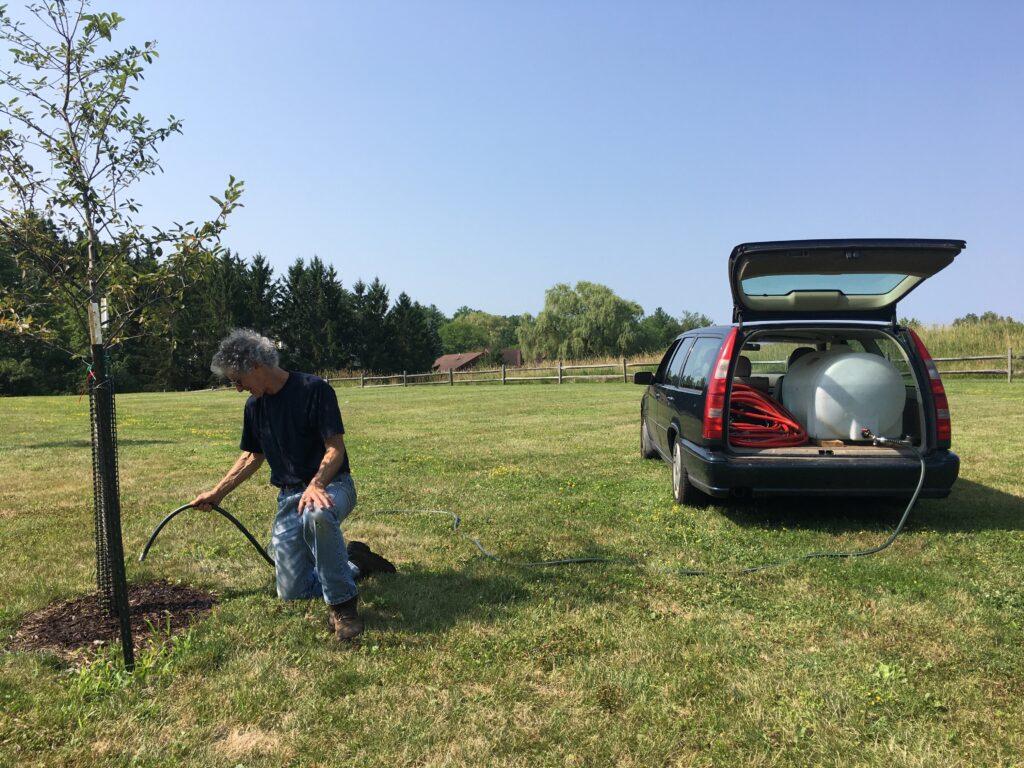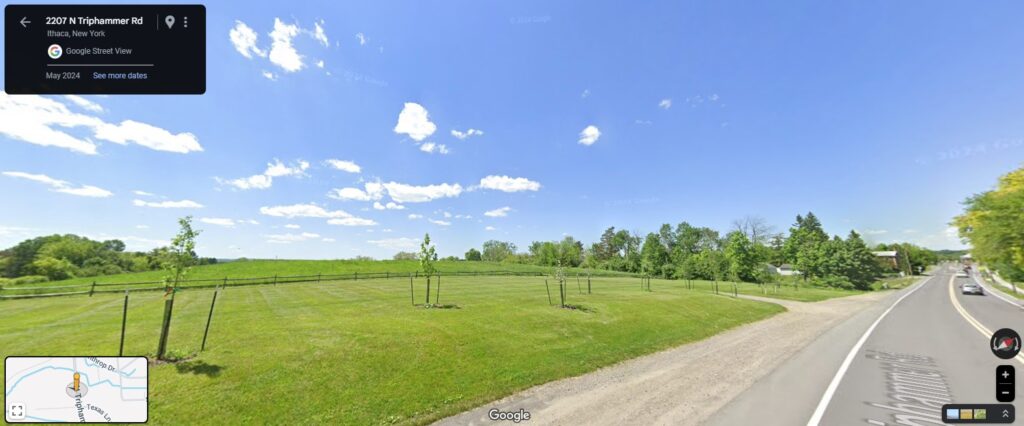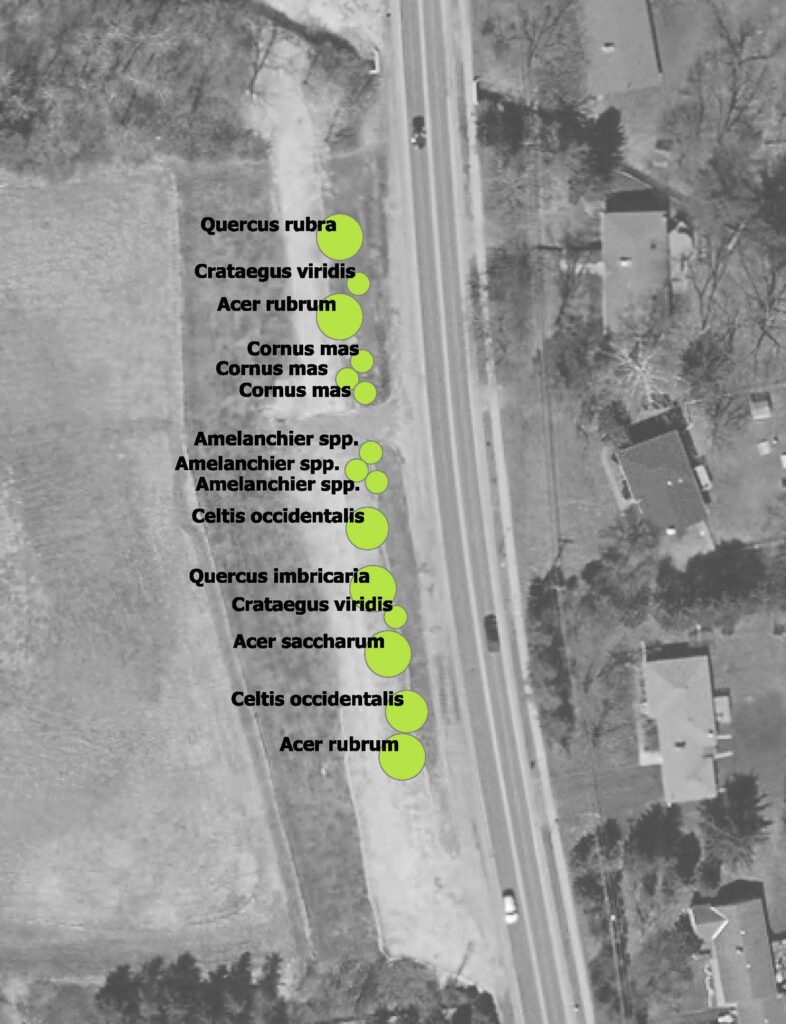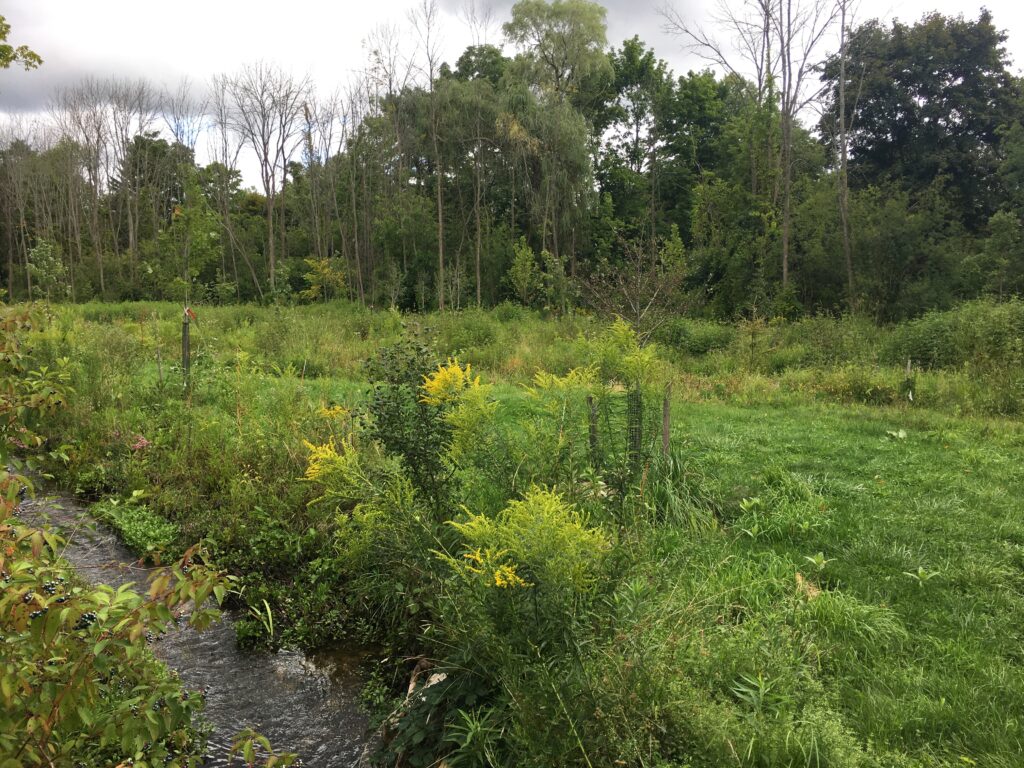Driving to meet a friend for lunch in the recently renovated café of Kendal at Ithaca one hot and humid July morning, there was Fred Cowett, village forester and planning board chair, watering young trees you may have seen at the south end of the Kendal property on North Triphammer Road. Returning home after lunch, he was still at it, so I had to stop and chat. Cowett is taking care of fifteen newly planted trees on a strip of property roughly three hundred feet long that falls within the Village of Cayuga Heights street right-of-way.
Cowett became a member of the Cayuga Heights planning board in 2010, shortly after the board was created and tasked by the mayor and trustees with producing the first village comprehensive plan. Ten years later, when Andre Bensadoun retired after longtime service as village forester, he took over that post, too. Holding a doctorate in horticulture from Cornell focusing on urban forestry and having conducted tree surveys of Cayuga Heights and many other municipalities, we are lucky indeed to have him.

Even though there are two large Bolton Point watermains nearby that run parallel to the trees, there is no way to access that water and provide the supplemental irrigation required during dry spells until the trees become established. Hauling water in a fifty-five-gallon tank in the back of his Volvo station wagon and watering each tree thoroughly but gently enough not to disturb the soil and mulch around its base is a painstaking job requiring time and patience. The trees, all of which are deciduous, were selected in consultation with Cowett, working closely on their placement with former village trustee Jim Marshall who initiated and developed the tree planting project and secured village funding for it. Holes for all fifteen trees, sourced bare root from Schichtel’s Nursery in Springville, New York, were dug by village public works staff members on a cold and snowy day last November. This was also supervised by landscape gardener Sandra Fish who installed wire supports and tree protection guards. Since the trees have been planted, Kendal grounds personnel have been very helpful in carefully mowing the grass between them.

The accompanying screenshot, taken for Google maps in May this year, shows the design of the planting in front of the split rail fence at the bottom of the Kendal meadow rising above North Triphammer Road. The two rows of trees are staggered one behind the other in a zigzag pattern on either side of the parking pull-off near the middle of the whole group. In the foreground are six trees that will grow tall in time, beginning with a red maple not shown in the back row, a hackberry slightly in front of it, followed by a sugar maple, green hawthorn, shingle oak and another hackberry. Three smaller, serviceberry trees are next to the near side of the pull-off, with three cornelian cherry dogwood trees on the opposite side. The remaining three trees are another red maple, a green hawthorn and a northern red oak that may grow to be the tallest of the fifteen trees in years to come.

Other new trees have been planted since the removal two years ago of trees killed by the emerald ash borer beetle on a woodland floodplain on the northwest side of Kendal. I was shown these new trees on a cool and rainy morning in mid-August by resident Hazel Dayton Gunn, a day when those along Triphammer Road certainly didn’t need watering. The former editor of an academic journal in the field of economics with an interest in climate change who undertook the first Kendal tree survey after moving in five years ago, Gunn co-chairs the senior living facility’s sustainability committee. We met up on the paved walking path that encircles the 100-acre Kendal property from which we could see where dozens of ash trees were cut down in September 2022. Gunn began our conversation by explaining that many of them posed a serious risk because they were losing branches and could fall along a mown footpath parallel to Renwick Brook flowing through Kendal on its way to Cayuga Lake.
The tree removal left a strip of land roughly 350 feet long and 30 feet wide bare at the time, but you wouldn’t know it today. Gunn pointed out the results of a tree replacement project since then, undertaken by residents and staff with approval and encouragement from the Cayuga Heights planning board. Two hundred riparian plants and bare-root saplings were planted in 2023, obtained from the New York State Department of Environmental Conservation nursery in Saratoga.

In addition, 29 species of trees, taller than the seedlings and marked by stakes and deer cages, have been purchased by the Kendal Residents’ Association and planted by the Cayuga Landscape Company. Native plants and some not-so-native plants and grasses have self-seeded around the trees and made almost the entire replanting area green again. Gunn considers them “planted by nature.”
Written by: Beatrice Szekely, Village Historian, with much help from Fred Cowett and Hazel Dayton Gunn